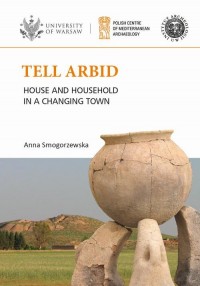Tell Arbid. House and household in a changing town. PAM Monograph Series 9
Anna Smogorzewska

| Dane szczegółowe: | |
| Wydawca: | Wydawnictwa Uniwersytetu Warszawskiego |
| Format: | |
| Ilość stron: | 474 s. |
| Zabezpieczenie: | plik z zabezpieczeniem watermark |
| EAN: | 9788323540984 |
| Data: | 2024-11-20 |
Opis e-booka:
Przedstawione w publikacji wyniki badań archeologicznych w jednej z dzielnic mieszkalnych na stanowisku Tell Arbid dostarczyły nowych danych na temat jednego z kluczowych momentów w rozwoju Syryjskiej Dżeziry (EJZ2–EJZ3, 2550–2350 p.n.e.) – okresu transformacji społeczno-gospodarczych a jednocześnie okresu najbardziej dynamicznego w rozwoju samego stanowiska. Rezultaty badań pozwoliły na lepsze poznanie jak funkcjonował dom i gospodarstwo domowe w średniej wielkości mieście z punktu widzenia kultury materialnej, organizacji społecznej, zasobów gospodarczych czy życia codziennego mieszkańców.The exploration of house and household—architecture, domestic features and artifacts—from a major site in the Syrian Jezirah at a key period in the development of the region (EJZ2–EJZ3, that is, 1550–2350 p.n.e.) has given a vivid picture of the life of an ancient community, its material culture, social organization, economic resources and daily activities at the time of its greatest development. Tell Arbid in northeastern Syria was a middle-sized town whose rise and expansion was particularly dynamic in the Ninevite V period (EJZ1–EJZ2), reflecting the robust urbanization processes that were part of a widespread socio-economic transformation of the region at the time.
A study of the results of more than 10 years of archaeological investigation of Area D on Tell Arbid, focusing on the sphere of community life in one of the urban districts recognized in the town, has given new insight into the way of life of the inhabitants and the functioning of the house as an economic unit, as well as the nature of food preparation and home industries, recognizing in greater depth the social and economic structure of the community that once inhabited this town.
E-book „Tell Arbid. House and household in a changing town. PAM Monograph Series 9” - Wydawca: Wydawnictwa Uniwersytetu Warszawskiego. Cena 158.30 zł. Zapraszamy na zakupy! Zapewniamy szybką realizację zamówienia.
Spis treści:
Chapter 1. Geographical context and archaeological evidence 9
1.1 Location and natural setting 9
1.2 Occupation history 12
1.3 Research history 14
Chapter 2. Area D. Methodology and stratigraphy 15
Chapter 3. Architecture 17
3.1 Materials and techniques 17
3.1.1 Mudbricks 17
3.1.2 Mudbrick patchwork 17
3.1.3 Wall and floor coating 17
3.2 Street and doorways 18
3.2.1 Street 18
3.2.2 Doorways 19
3.3 Architectural units 21
3.4 House concepts in the Syrian Jezirah. EJZ 2-EJZ 3 periods 72
3.5 House concepts in Area D. Late EJZ 2-EJZ 3 74
3.6 Houses in the economic and social context 77
3.7 Storage and crop processing facilities 78
3.8 Domestic features 83
Chapter 4. Pottery 103
4.1 Pottery classification 103
4.1.1 Pottery morphology 103
4.1.2 Technological classification 104
4.1.2.1 Fabric 104
4.1.2.2 Method of manufacture 104
4.1.2.3 Secondary forming techniques 107
4.1.2.4 Surface treatment 107
4.1.2.5 Firing 107
4.1.2.6 Color 108
4.1.2.7 Pottery tools 110
4.2 Technological classes of pottery 110
4.2.1 Fine ware 110
4.2.1.1 Technological groups 111
4.2.2 Common ware 112
4.2.2.1 Technological groups 112
4.2.3 Coarse ware 112
4.2.3.1 Technological groups 113
4.3 Pottery types 113
4.3.1 Fine ware bowls 113
4.3.1.1 Morphological types 113
4.3.1.2 Fine ware bowls by phase 120
4.3.1.3 Function 121
4.3.2 Fine ware jars 122
4.3.2.1 Morphological types 122
4.3.2.2 Fine ware jars by phase 126
4.3.2.3 Function 126
4.3.3 Common and coarse ware bowls 127
4.3.3.1 Morphological types 127
4.3.3.2 Technology 128
4.3.3.3 Common and coarse ware bowls by phase 129
4.3.4 Common and coarse ware jars 129
4.3.4.1 Morphological types 129
4.3.4.2 Technology 131
4.3.4.3 Common and coarse ware jars by phase 132
4.3.4.4 Function 132
4.3.5 Special types 133
4.3.5.1 Pot stands 133
4.3.5.2 Strainers 135
4.3.5.3 Decantation vessel 136
4.3.5.4 Ladle 136
4.3.5.5 Double-mouthed pot 136
4.3.6 Kitchen Ware 137
4.3.6.1 Morphological types 137
4.3.6.2 Technology 139
4.3.6.3 Kitchen Ware by phase 141
4.3.7 Metallic Ware 142
4.3.7.1 Morphological types 143
4.3.7.2 Metallic Ware by phase 144
4.3.8 North-Mesopotamian Grey Ware 144
4.3.9 Euphrates Banded Ware 145
4.3.10 Jezirah Burnished Ware 146
4.3.10.1 Morphological types 146
4.3.10.2 Technology 149
4.4 Rims, bases and appendages 150
4.4.1 Fine ware bowl rims 150
4.4.2 Fine ware jar rims 151
4.4.3 Common and coarse ware bowl rims 152
4.4.4 Common and coarse ware jar rims 152
4.4.5 Pot stand rims 153
4.4.6 Kitchen Ware rims 153
4.4.7 Bases 153
4.4.8 Appendages 154
4.5 Decorative motifs 155
4.6 Pottery in Phases A-D (late EJZ 2-EJZ 3 periods). Main trends and types 159
4.7 Chronological observations in pottery development (Phases A-D) 163
Plates 166
Tables 392
Chapter 5. Burials 409
Chapter 6. Sm all finds 419
6.1 Stone tools 419
6.2 Lithics 424
6.3 Zoomorphic and anthropomorphic figurines 424
6.4 Glyptic 431
6.5 Beads and pendants 433
6.6 Spindle whorls 435
6.7 Needles and pins 436
6.8 Tokens 436
6.9 Metal objects 436
6.10 Model vehicles 437
6.11 Model wheels 438
6.12 Pierced pottery discs 438
6.13 Pottery scrapers 443
Chapter 7. Subsistence economy 445
Chapter 8. Conclusions 449
References 452
List of figures and tables 466

